Comparison of Costs
of Post Secondary Education at Three Different Canadian Universities
Teachers Comments are
placed throughout this project in Green
Site
Contents: Introduction
| Student Profile
| UWO |
UBC | UofA |
Comparisons | Conclusion
| Evaluation
| References
| End of Project
By
Mary & Gwenneth
Introduction:
In this project, we will investigate
the cost of post secondary
education at three different universities in Canada, the University
of British Columbia, the University of Alberta and the University
of Western Ontario. This not only entails the tuition, but also
books, transportation, meals, residence and other fees (spending
money, laundry, phone calls home, etc.) as well as other factors
such as location and quality of education. We have created a specific
student profile, included below, to simplify the analysis of the
costs. The costs will be represented in three different forms;
written, pie graphs and
bar graphs to compare
between the universities and to compare different costs within
each university After putting all the information and graphs,
we will be able to make a decision about which university is best
for the student in question.
Student
Profile:
Jill Smith is a seventeen-year
old Grade 12 student in Regina, Saskatchewan. She is hoping to
go into the Faculty of Science or Art next year to get her BSc
or BA, but she doesn't know which university she wants to go to.
Jill was accepted at UBC, U of A and the University of Western
Ontario. She will need to stay in residence at the university
she choose and she does not own a car but will need some form
of transportation while she is away. Also, she will require other
amenities while attending university, so these have been included
in the budget. Jill wishes
to attend a reputable university, which will provide her with
a quality education and is interested in living near Toronto.
- How much funds are
available for Jill?
- How is she going to
raise the funds?
- Will she work Part
time?
- If so, what is the
expected pay?
- How many hours can
she work in a week? Day?
- Compute Jill's salary, gross
wage, deductions, take
home pay, etc.
- Will Jill need a student
loan
- If so, how much?
- How will she eventually
repay it?
- Will Jill win any awards
of scholarships? How much?
Problems to be explored for
each of the three Universities examined:
I) What is the cost of tuition
and books?
2) What is the cost of living
in residency and food?
3) What are the other costs
of living at this university? (transportation, laundry, etc.)
4) What is the total for one
year at this institution?
5) What percentage of the
total cost is each of the above components?
- What other factors
could you consider?
- Mode of paying tition--per
term, per month, yearly, installments?
- What form of payment--cash, credit
cards, cheque?
The University
of Western Ontario
1) What is the cost of tuition
and books?
The projected tuition for
the 2000/2001 at The University of Western Ontario is $4 598.49.
The projected cost of textbooks and other reading materials
is $800.00.
2) What is the cost of living
in residency and food?
The cost of living is residency
at the University of Western Ontario is projected to be $5,191.00.
In this cost is included food and utilities.
3) What are the other costs
of living at this university? (transportation, laundry, etc.)
The cost of in-city transportation
in London Ontario is nothing, as this cost is included in the
tuition fees. Phone fees for the Winter session should be around
$200. The cost of personal items, clothing and entertainment
should be about $440, $400, and $680, respectively. The cost
of Laundry for the Winter session should be about $170.
4) What is the total for one
year at this institution?
The costs previously mentioned,
when accurately added should give a realistic estimate of the
cost of attending this university.
$4 598.49
800.00
5 191.00
200.00
440.00
400.00
680.00
+170.00
$12479.49
The total cost of one year
at The University of Western Ontario is estimated to be $12479.49.
5) What percentage of the
total cost is each of the above components?
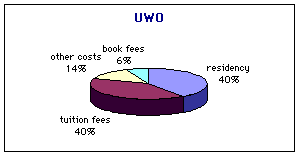
From this pie graph, it can
been seen that the majority of the cost of attending The University
of Western Ontario comes from residency and tuition fees. The
cost of texts and other necessary reading resources compose the
smallest part of the cost. Other costs, such as laundry money,
phone fees, personal items, clothing and entertainment also can
be seen to be a small amount of the costs of attending this University,
but are significantly larger than those cost going towards the
purchase of books.
The University
of British Columbia
1) What is the cost of tuition
and books?
The projected tuition fees
for the 2000/2001 Winter Session at the University of British
Columbia is $2 295.00 for Canadian Citizens and Permanent Residents.
The cost of books and other supplies should be about $500.
2) What is the cost of living
in residency and food?
The cost of residency at the
University of British Columbia, with a mandatory meal plan is
at a rate of $800.00 per month is $ 6 400.00. Also included in
this cost are utility fees.
3) What are the other costs
of living at this university? (transportation, laundry, etc.)
The student fees should present
a cost of about $233.75. The projected fees for the 2000/2001
school year were unavailable, so the cost of last year's student
fees was used in this activity. The cost of transportation around
the locality of Vancouver at a rate of $54 per month should come
to a total of $432.00 over the course of the 2000/2001 Winter
Session. Other miscellaneous, including clothing should come
to a total cost of $1 600.00. The cost of Health Insurance, as
the profile being examined is that of a Canadian Citizen and
Resident will be nothing.
4) What is the total for one
year at this institution?
The cost mentioned above,
when accurately added should give an accurate estimate of the
total cost of attending this institution for one year.
$ 2 295.00
500.00
233.75
6 400.00
432.00
+ 1 600.00
$11 460.75
The total cost for attending
one year of University at The University of British Columbia
is estimated to be $11 460.75.
5) What percentage of the
total cost is each of the above components? See pie graph below:
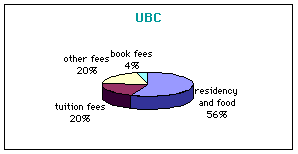
From the pie graph above,
it can been seen that the majority of costs come form residency
and food fees. The next two highest contributors to the cost
of attending this institution are tuition and other miscellaneous
fees. Of the four areas shown on this graph, the cost of texts
and other reading materials made up the smallest contributor
to the total cost of attending this institution by a wide margin.
The University
of Alberta
1) What is the cost of tuition
and books?
The cost of tuition at the
University of Alberta for a first year undergraduate student
is approximately $ 3 900.00. The cost of books at this institution
should be $1000.00.
2) What is the cost of living
in residency and food?
The cost of residency at Lister
Hall should cost about $1 480.00 in a shared room. The cost of
the mandatory meal plan is on average $1 900.00. Utilities are
included in this cost.
3) What are the other costs
of living at this university? (transportation, laundry, etc.)
At the University of Alberta,
transit passes are available for the cost of $50.00 per month.
During the time period of a the Winter Session at this institution,
the cost of transportation would therefor be $400.00. For other
expenses, including phone services, personal items, recreational
activities, clothing an amount of $1 600.00 will be used.
4) What is the total for one
year at this institution?
The cost mentioned above,
when accurately added should give an accurate estimate of the
total cost of attending this institution for one year.
$3 900.00
1 000.00
1 480.00
1 900.00
1 600.00
+ 400.00
$10280.00
5) What percentage of the
total cost is each of the above components? See pie graph below:
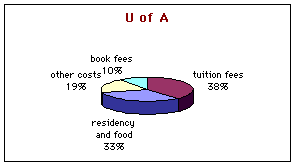
As can be seen from this pie
graph, the majority of costs at The University of Alberta come
from tuition fees. The next major contributor to cost is the
fees of residency and food. Miscellaneous costs contribute about
19% of the cost of attending this institution, as can be seen
above. Book fees make up the smallest portion of the cost in
this scenario.
Compare
the three Universities in terms of tuition fees, residency fees,
and total cost.
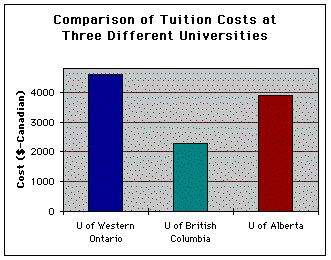
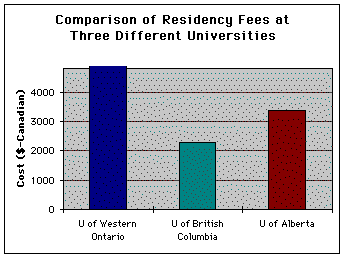
- The wrong number is
graphed for the U of British Columbia residency fees. In the
project you said that the cost of residency was $6 400, but you
actually graphed $ 2 295 which was the cost of tuition.
-
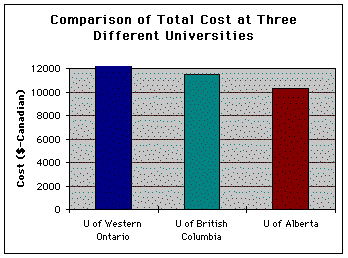
Conclusion:
After considering all the information,
Jill has decided to attend the University of Alberta for several
reasons. Although the University of Western Ontario is near Toronto,
Jill felt that the total
cost to attend this institution was too high to justify attendance.
The University of British Columbia had no special attraction for
Jill and since it is a further distance from her home, she decided
that trips home would be easier and more economical
at the University of Alberta. All three universities have very
good reputations and Jill was certain she would get a quality
education at any of the institutions.
Evaluation
of Activity:
In investigating this question,
we have learned useful information regarding university costs.
Its worth in "real life" is proven yearly as students
preparing for post secondary education ask the same questions
as addressed in this report. As such students ourselves, we found
this activity quite useful. Using the hypothetical Jill as an
example, we have discovered the many costs of attending university,
as well as the diversity of costs between universities across
Canada. This activity has also allowed us to know where resources
are available to help us in our decision making process.
References:
1. www.ualberta.ca
2. www.student-services.ubc.ca
3. www.registrar.uwo.ca
4. Change the World Guidebook,
The University of Western Ontario.
5. Your University for
the 21st Century, The University of British Columbia.
6. No Boundaries Prospective
Student Handbook 2000/2001, The University of Alberta.
Top of Page
University
Project |
Student Projects Home Page





